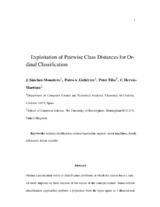Exploitation of Pairwise Class Distances for Ordinal Classification
Autor
Sánchez-Monedero, J.
Gutiérrez, Pedro A.
Tino, Peter
Hervás-Martínez, César
Fecha
2013-07-15Materia
Ordinal classificationOrdinal regression
Support vector machines
Threshold model
Latent variable
METS:
Mostrar el registro METSPREMIS:
Mostrar el registro PREMISMetadatos
Mostrar el registro completo del ítemResumen
Ordinal classification refers to classification problems in which the classes have a natural
order imposed on them because of the nature of the concept studied. Some ordinal
classification approaches perform a projection from the input space to 1-dimensional (latent) space that is partitioned into a sequence of intervals (one for each class). Class
identity of a novel input pattern is then decided based on the interval its projection falls
into. This projection is trained only indirectly as part of the overall model fitting. As
with any latent model fitting, direct construction hints one may have about the desired
form of the latent model can prove very useful for obtaining high quality models. The
key idea of this paper is to construct such a projection model directly, using insights
about the class distribution obtained from pairwise distance calculations. The proposed
approach is extensively evaluated with eight nominal and ordinal classifiers methods,
ten real world ordinal classification datasets, and four different performance measures.
The new methodology obtained the best results in average ranking when considering
three of the performance metrics, although significant differences are found only for
some of the methods. Also, after observing other methods internal behaviour in the
latent space, we conclude that the internal projection do not fully reflect the intra-class
behaviour of the patterns. Our method is intrinsically simple, intuitive and easily understandable,
yet, highly competitive with state-of-the-art approaches to ordinal classification

